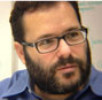Authors: Dave Malouf
Posted: Wed, February 20, 2013 - 4:20:01
This past week I was in the position to talk a lot about how I design with storytelling. It was the first time for me where I was placed with incredibly smart, mostly analytic engineers, and had to explain not only how design would be able to help them, but also how storytelling as a tool of design was so important to that larger design process.
The problems these engineers are challenged with are truly incredible. I have never before faced the same level of mission criticality combined with seemingly infinite scope. One engineer asked me a question that felt so contextually relevant in this context that the question, which had been heard before, had been reborn with a completely new meaning: "How do you use design to keep limits or boundaries on you and your team's creativity?"
The term "thinking within the box" was framed as a positive, and I could tell that given their infinite scales of scope, it was important for the teams to work from a position of grounding. I actually had an answer about how to do that. I've always appreciated the way Luke Wroblewski reframed the classical architectural technique of "parti" as a structural and stepped framework for doing just that. However, I also find that parti framed in that way is best when scales of scope have managed understanding, and so it might be too limiting in these larger contexts.
I realize I'm being vague about the exact context. I'd say these types of problems and their probable solutions are somewhere between the wicked problems of world health and hunger, and designing an entire transportation infrastructure from the ground up. In fact, the problems themselves can be relatively easily articulated, but they live at the very fringe of human capability that the solutions require a very reframing of what human capabilities are.
So, within this newly immersed context I had to look at the question itself in a different way and reframe the question itself, from "How do we stay inside the box?" to "How do we not wonder too far off course?" In so doing, it was easy for me to just jump into my comfort zone of storytelling.
Why story?
Stories, especially written stories (or otherwise loosely illustrated), beg us to use our imagination. We have to fill in so many gaps, fix so many plot holes, and illustrate so many settings, situations, artifacts, and characters. Further, the use of emotion, which elicits so much empathy, drives our engagement in this process.
This process, though, isn't bounded. It is boundless. However, while the invitation is open to all imaginative creations, the story offered itself acts as a critical framework for evaluating the results of the creativity. But unlike other frames, stories favor expansion over limits. This allows a different type of evaluative process that uses gravity to pull in good ideas and let bad ideas fly out of orbit. Further, as new ideas get added and assimilated into the story/system, the properties of the gravitational field evolve.
This method can easily be summed up as "throw something onto the pile and see if it sticks." But how do you "throw things on"?
It all depends where you are in the process. Early is low-fi. Further downstream is higher-fidelity. And the higher the fidelity, the looser the gravity (or the more picky you become). In essence, the process looks a lot more like script writing and movie making than product design when you first start out. The goals are experiencing, improvisation, and framing. It isn't even about simulations or empathy in the earliest stages, but rather setting and plot development against loosely outlined characters.
Once it starts to come together verbally, it's time to start visualizing. Storyboards, video captures of improvisational sketches, and motion graphic presentations begin to fill in the initial gaps. Follow this with artifact design, state management, and cleaning up the story itself to be more in line with new research and course corrections.
At some point near here, prototype development of artifacts begins. Always start where the questions are biggest, where experience is least, and where our imaginations will have the hardest time consistently filling in the gaps. But the role here is still more like a production artist or prop master than an engineer.
This process of filling in more and more detail at higher and higher fidelity has the primary goals of experiencing and provoking. It isn't until a complete scenario has been simulated and experienced, and a consensus built on feasibility, appropriateness, and correctness of direction has been reached that the transition from simulation to production kicks in.
The story at this point transitions from a frame for creativity to an outline for project management, the same way a completed script is used to produce a movie. It isn't linear, but it does have structure that offers dependencies, resource requirements, and a map of the complete system.
A good improvisational director, though, has something that a traditional movie director doesn't have to deal with: contingency. So during the story development process one of the elements that is captured are the alternative paths, exceptions, and other types of contingencies that complex interactive and intelligent systems need to employ.
For me this is the designer's best path for designing particularly ornery systems that require an especially high volume of creative ideas even to just understand the problems, let alone solve them. These contexts of problem understanding and solving can't afford to be boxed in, yet can't be allowed to spin out of control without a firm gravitational (even if always evolving) center.
Posted in: on Wed, February 20, 2013 - 4:20:01
Dave Malouf
View All Dave Malouf's Posts






Post Comment
No Comments Found